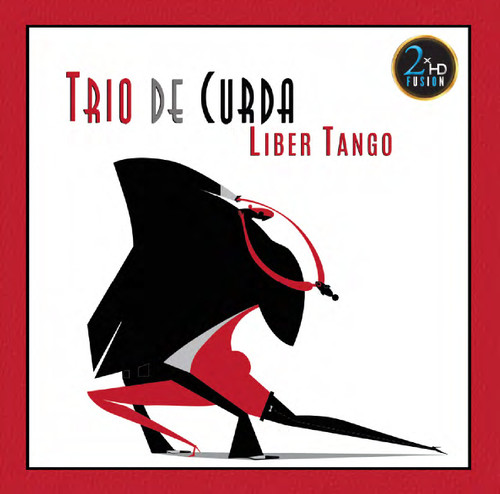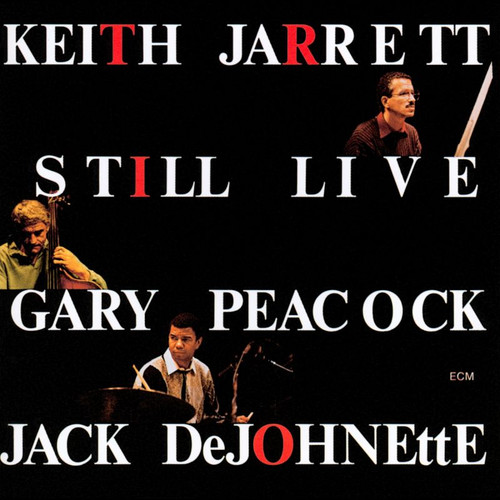“This is the chill-out as a state of grace, and it can go as deep as you like. Sublime,” wrote the Independent on Sunday of the Gustavsen’s trio’s Being There, released in 2007. Over the last decade Tord has explored other ensemble forms and formats, but on The Other Side - recorded at Oslo’s Rainbow Studio in January 2018 – he opens a new chapter in his piano trio story, with faithful drummer Jarle Vespestad, and excellent new bassist Sigurd Hole. Hole’s approach to his instrument, drawing on folk influences as well as modern jazz, is ideally suited to Gustavsen’s slowly-developing, deeply melodic pieces. The album, produced by Manfred Eicher, is issued on the eve of a major tour.
FEATURED ARTISTS
TRACKLIST
A1 The Tunnel, Music By – Tord Gustavsen 6:02
A2 Kirken, Den Er Et Gammelt Hus, Arranged By [Arr.] – Tord Gustavsen, Music By – Ludvig Mathias Lindeman 5:13
A3 Re-Melt, Music By – Tord Gustavsen 5:15
A4 Duality, Music By – Tord Gustavsen 4:35
A5 Ingen Vinner Frem Til Den Evige Ro, Arranged By [Arr.] – Tord Gustavsen, Music By – Trad. 3:50
A6 Taste And See, Music By – Tord Gustavsen 3:13
B1 Schlafes Bruder, Arranged By [Arr.] – Tord Gustavsen, Music By – J. S. Bach 4:51
Jesu, Meine Freude / Jesus Det Eneste (4:27)
B2.1 Jesu, Meine Freude, Music By – J. S. Bach, Arranged By [Arr.] – Tord Gustavsen
B2.2 Jesus Det Eneste, Music By – Trad., Arranged By [Arr.] – Tord Gustavsen
B3 The Other Side, Music By – Tord Gustavsen 3:23
B4 O Traurigkeit, Arranged By [Arr.] – Tord Gustavsen, Music By – J. S. Bach 3:31
B5 Left Over Lullaby No. 4, Music By – Tord Gustavsen 2:26
B6 Curves, Music By – Tord Gustavsen 6:19
BACKGROUND
Pianist Tord Gustavsen began his ECM tenure with three trio albums, released from 2003 to 2007, that enjoyed a remarkable confluence of popular and critical success. JazzTimes described this trilogy as having the potency of “distilled magic,” while the Guardian stated “Gustavsen’s tunes are hypnotically strong, and the integration of bass and drums in his regular trio is total.“ In four further recordings for ECM over the past decade, Gustavsen explored the quartet format, as well as worked with an expanded ensemble and vocals. Now, for his return to trio with the album The Other Side, the Norwegian pianist has convened a new working group, which includes ever-faithful drummer Jarle Vespestad – a kindred spirit who has drummed on all of Gustavsen’s albums. There is a new bassist, Sigurd Hole, whose eclectic approach to his instrument – drawing on influences from folk music as well as modern jazz – makes him ideally suited to the pianist’s gradually developing, melodic pieces. The Other Side incorporates Gustavsen’s love for the church music of his village youth and the ancient folk melodies of Norway that have become a passion in more recent years. This mix of compositions and arrangements of chorales ranges from grave beauty to flowing dynamism, marked throughout by the trio’s seemingly telepathic chemistry.
Along with being 11 years since Gustavsen’s previous trio album, it has been seven years since the tragic early passing of the group’s original bassist, Harald Johnsen. “I didn’t want to just continue the trio with another bassist,” Gustavsen explains. “Then the quartet I had with Jarle, saxophonist Tore Brunborg and bassist Mats Eilertsen felt so strong that it demanded its own cycles of recording and touring. After that, we did like to explore new songs with electronics and vocals. But following all this, it seemed like the time to bring the piano back as the lead voice. This new version of the trio feels in line with the initial group, even as it exists on another wavelength – it would have to, as it somehow includes all that came in between those first records and now. And, the trio represents Tord’s passion for paradoxically uniting clarity and freedom.
The title of The Other Side reflects multiple ideas, it also refers to the trio as being another side of Gustavsen’s music-making from the quartet and vocal explorations of recent years, not to mention his frequent side ventures with choirs, fiddle players and even Iranian musicians. “Then there is also this idea in the title of the way the trio plays as being the other side of virtuosity, a kind of paradoxical virtuosity where you don’t play all the notes you can but merely the notes that are really needed,” he says. “It’s about subordinating your ego to the flow of the music – and that takes a kind of ‘radical listening’ – listen more than you play. That’s a passion the three of us share.”
Gustavsen arranged several chorales by Bach for the album, as well as one by 19th-century Danish composer, organist and folklorist Ludvig Mathias Lindeman. Bach’s “Schlafes Bruder” has deep groove led by Vespestad, while Lindeman’s “Kirken, den er et gammelt hus” has a feel that’s alternatively ruminative and rhapsodic, with an electronically shaded intro. “We’re interpreting the church music that I grew up with in an abstract way,” the pianist explains.
Gustavsen composed the grooving “Re-Melt” and haunting “Leftover Lullaby No. 4” as divergent responses to the chorale arrangements. He originally wrote the gospel-tinged “Tunnel” and melodic highlight “Taste and See” for a literary festival in the mountains of northwest Norway, where the pieces were played in conjunction with readings; they evolved further as vehicles for the trio. The stately, blue-hued title track and ravishing “Curves” are original pieces that Gustavsen composed at soundchecks on quartet tours, inspired by how the other group members were responding musically to his ideas; the seeds of the quietly atmospheric “Duality” were also sown in that way, but the track ended up as a mostly free improvisation in the studio.
Always subtle and lyrical, Gustavsen’s pianism has evolved in recent years to incorporate more modal playing, moving beyond chord changes; through his quartet work and his early experiences as a solo performer, his blending of composition and improvisation has also become freer, more seamless. Both of his trio mates have sensual sounds that complement his own. Sigurd Hole has a lyrical bent on bass, although his arco playing can be expressively percussive. “Sigurd also has a natural way of injecting modal Norwegian folk melodies into the music that makes the group’s connection to these roots stronger,” Gustavsen points out. “The old Norwegian lullabies and dance forms find their way in now almost without us thinking about it.”
Gustavsen and Vespestad, musical soul mates, have played hundreds of concerts together. “Early on, in our playing of ballads, we discovered this sense of micro-timing, and loaded minimalism – the feeling that the less we play, the stronger it gets – and this sense has evolved ever since. Now, we are also stretching out and using more dynamics, but this fundamental experience of ‘essence’ and reduction is always our point of departure. Jarle can groove in such an understated way and play so quietly that all the timbres of the piano can be heard. That said, he has such technical ability. It’s fascinating that beyond his groups with me, he often plays complex music with fierce tempos and a lot of volume and noise. A funny thing is that he’s so attuned to the lyricism in the trio’s music that I can often hear him humming the melody as he plays. That’s rare for a drummer and something that, as a composer, I find touching.”
“I like to analyse and break things down in music, of course, but first and foremost, it’s about touching people in the way that I like to be touched in music,” Gustavsen concludes. “That’s the most meaningful part of all this for me, being moved and moving others.”
3 Reviews Hide Reviews Show Reviews
-
Great piano jazz
Seems like the only melodic jazz is coming out of Scandinavia. This group is one of the best, and the sonics are superb.
-
Big fan of Gustavsen
This recording is simply another instance of first rate musicianship and artistic sensibility. If you haven't listed to Gustavsen's bands, you're really missing out. he's great.
-
A Spiritual Jazz Journey
With 13 tracks of beautiful, impressionistic tracks, this is another classic ECM recording of gentle, quiet Scandinavian free jazz explorations. Here, Norwegians Tord Gustavsen on piano and electronics, Sigurd Hole on double bass, and Jarle Vespestad on drums commence their album with a dark, intriguing episode called The Tunnel and present several takes on religious hymns on this musical journey. The Danish hymn Kirken, den er et gammelt hus [The church, it is an old house] is next, followed by the philosophical Re-melt and Duality, which are sparse and filled with doubt. Ingen vinner frem til den evige ro [No one wins the eternal calm] is a Norwegian hymn [Lars Linderot,1798], indicating that enlightenment is a struggle. Taste and See is the band's suggestion to Just Do It. Schalefes Bruder [brother of sleep] is next and it refers to "Come, o death, you brother of sleep" from Johann Franck's 1653 hymn Du, o schönes Weltgebäude. Like J.S. Bach, whose cantatas include such hymns, the Trio seeks to convey the same sentiments. Jesu meine Freude [Jesus, my joy] is another Johann Franck hymn, which is followed by Jesus, det eneste [Jesus, the only one], a more recent song by Norwegian Ole Theodor Moe [d. 1922]. The title track, The Other Side, thus is put into context of religion. O Traurigkeit [O darkest woe] came from the quill of Johann von Rist, 1637 and laments the death of Jesus. The final works are a lullaby and Curves. This contemplative album, therefore, is consistently lyrical and lacking of groove. Ignoring the hymnal text origins, the music alone, particularly to a listener not familiar with such core melodies, promotes reflection








